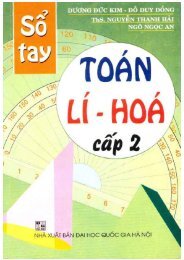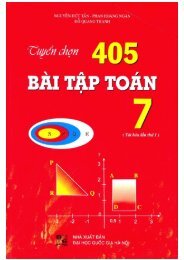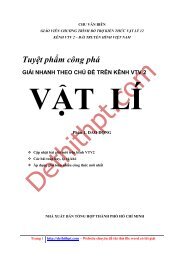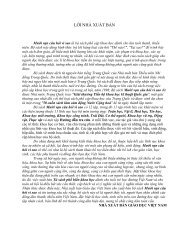Sách giáo viên Tiếng Anh 9 Thí điểm 2 tập (Pilot English 9 for Teacher)
https://app.box.com/s/rnv2yu1duebjhdpkknu2l47p9nmel5ax
https://app.box.com/s/rnv2yu1duebjhdpkknu2l47p9nmel5ax
You also want an ePaper? Increase the reach of your titles
YUMPU automatically turns print PDFs into web optimized ePapers that Google loves.
The Project helps students to improve their ability to work by themselves and in a team. It<br />
extends their imagination in a field related to the unit topic. The teacher can use this as an<br />
extra-curricular activity (<strong>for</strong> groupwork) or as homework <strong>for</strong> students to do individually.<br />
reFerence For SkIllS AnD lAnguAge teAcHIng<br />
1. teAcHIng reADIng<br />
Reading is the first of the four language skills that receives special attention in <strong>Tiếng</strong> <strong>Anh</strong> 9.<br />
- The reading activities in <strong>Tiếng</strong> <strong>Anh</strong> 9 aim to help students develop sub-skills such as<br />
skimming <strong>for</strong> gist and scanning <strong>for</strong> details.<br />
- Explanations should be given to students when they do not understand the meaning of<br />
a word. Some reading strategies such as focussing on familiar words, guessing unfamiliar<br />
words in context, etc. should be taught to students.<br />
- Be<strong>for</strong>e teaching the text, the teacher should encourage students to guess what the text is<br />
about, what new words may appear in the text, etc.<br />
2. teAcHIng SPeAkIng<br />
There are two <strong>for</strong>ms of speaking in <strong>Tiếng</strong> <strong>Anh</strong> 9: spoken interaction and spoken production.<br />
The <strong>for</strong>mer refers to the ability to ask and answer questions and handle exchanges with others.<br />
The latter refers to students’ ability to produce language appropriately and correctly.<br />
Speaking activities include:<br />
- Pronunciation: dialogues and role-plays. Through these <strong>for</strong>ms, students practise the intonation<br />
patterns of <strong>English</strong> in a natural way. It is crucial to provide students with a lot of models and<br />
to build up their confidence with acceptance of approximate correct pronunciation.<br />
- Repetition: helps students to memorise vocabulary and ‘chunks’ of language. Repetition<br />
and classroom routines build up an expanding repertoire of <strong>English</strong> that helps students<br />
understand and respond to a situation as a part of communicative interactions in class.<br />
One strategy is to provide a lot of opportunities <strong>for</strong> students to practise with a secure<br />
feeling through choral repetition of action rhymes and games. It is also important to<br />
establish classroom routines (such as greetings and saying goodbye) at the beginning and<br />
the end of the lessons. Asking <strong>for</strong> permission, using common classroom expressions (e.g.<br />
I don’t understand. Could you say it again, please? May I ask you a question?), or answering<br />
a question (e.g. I don’t know. I think/guess..., Perhaps...) are important language tasks <strong>for</strong><br />
students to practise daily.<br />
- Pair work/group work and class presentations: help students to talk freely in a language<br />
situation related to the topic of the unit. They also make students feel secure and promote<br />
their confidence in speaking.<br />
Error correction should be done cautiously by the teacher. When students are talking, the<br />
teacher should not stop them to correct their mistakes. Mistakes should be analysed and only<br />
common errors should be highlighted afterwards and corrected collectively.<br />
3. teAcHIng lIStenIng<br />
Through listening, students become familiar with the sounds, rhythms, and intonation of<br />
<strong>English</strong>. When listening to <strong>English</strong>, students are actively engaged in constructing meaning and<br />
making sense of what they hear, using their knowledge and the clues provided by the context.<br />
It is very important to teach students to be aware of the purpose, the content, and intonation<br />
of the listening text.<br />
IntRoDUCtIon<br />
V

















